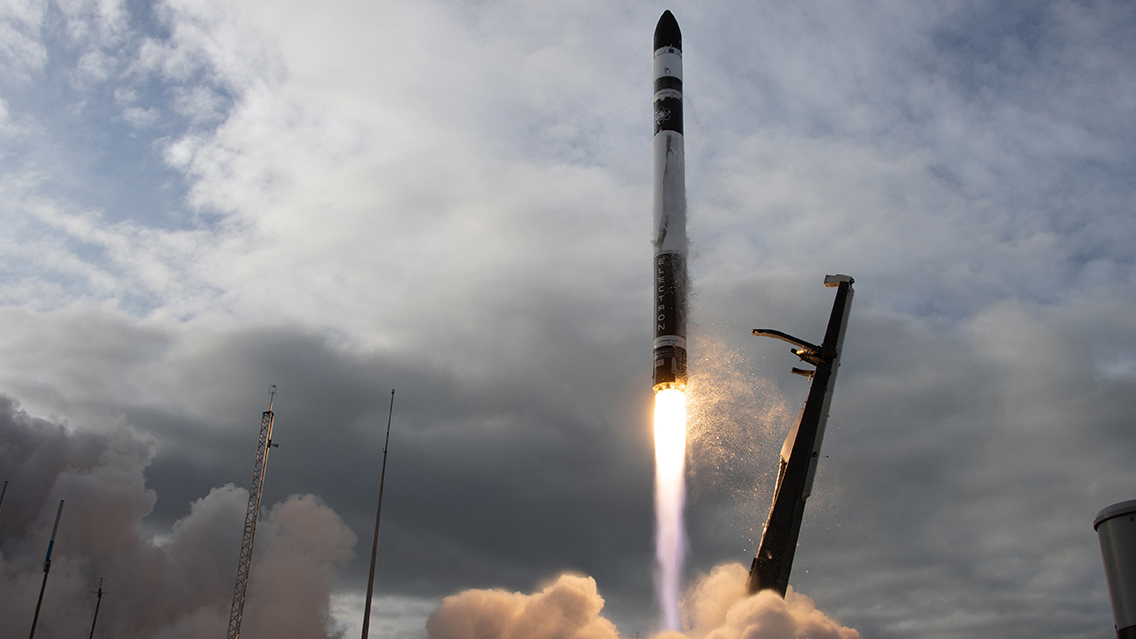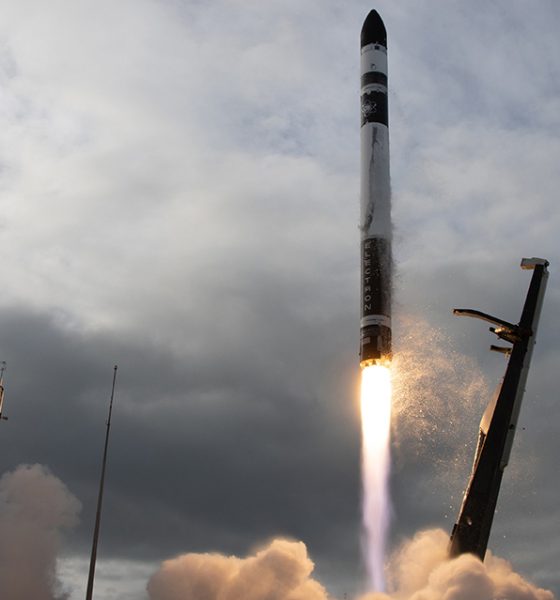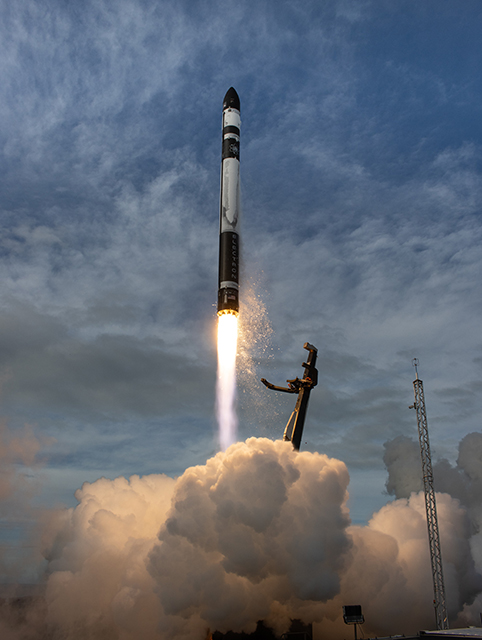

News
Rocket Lab to resume launches following in-flight anomaly investigation
Less than a month after the complete loss of customer payload due to an in-flight anomaly, Rocket Lab has announced that it is ready to return its small-class Electron rocket to flight. Company CEO, Peter Beck, during a media briefing Friday (July 31) said that the Electron second-stage “re-entered the atmosphere and burned up” resulting in a failed July 4 launch of the Electron and complete loss the customer payload of seven small satellites. Beck went on to state that through a collaborative investigation with the Federal Aviation Administration Rocket Lab was “able to quickly reconstruct what happened and the AIB board (Accident Investigation Board) was able to confidently narrow down the issue to a single electrical connection.”

The thirteenth flight of the Electron carried seven small satellites, all Earth-imaging inspiring the “Pics Or It Didn’t Happen” mission name. The rocket initially experienced a flawless launch from the company’s Launch Complex-1A on New Zealand’s Mahia Penninsula and everything seemed like it was going to plan until the video feed cut out unexpectedly shortly after the nominal ignition of the second-stage which was intended to carry the payloads to orbit.
The launch was completely event free during the first-stage ascent, stage separation, second stage ignition, and payload fairing jettison, then trouble occurred. Beck stated that the electrical connection that went bad during the second-stage of the flight was “incredibly unusual because it was able to evade all of the pre-flight acceptance testing.” Beck went on to explain that “while all of the testing showed no issues, after a period of time one of the joints had high resistance and that high resistance led to heating. That heating then led to thermal expansion of one of the components. That thermal expansion and heating enabled some of the potting components – that are around that joint to keep it secure from vibration – to flow.”
Once the potting compound used to secure electrical connections was able to heat up and essentially melt – or began to flow – the electrical connection become unsecured and led to the interruption in electrical current throughout the second-stage. Beck stated that “when the video stops (in the webcast) is exactly the point (of failure).” Although the video cut out, Rocket Lab ground stations continued to receive telemetry data of the flight’s progress due to the amount of redundancy with the systems aboard Electron “telemetry is the only way you can reconstruct this stuff so we have a very high priority of those (data) channels” Beck said.
With the immense amount of data that was received during the flight and throughout the second-stage shutdown Rocket Lab was able to quickly determine the cause of the error and perform tests to determine exactly what occurred during the failed flight. “The vehicle as it flies every flight has just a huge amount of instrumentation. That coupled with a graceful shutdown coupled with full telemetry stream throughout the whole anomaly, we were really able to quickly reconstruct what happened” Beck said.
The vast amount of data and the ability to sufficiently replicate the incident now means that Rocket Lab has a plan of action in place to mitigate any failures – of this nature – on future missions. “We can actually mitigate (the anomaly) very easily through a slight change in production processes, but more importantly we can screen for it in our current vehicles and stock through more in-depth testing procedures.”
To that end, the Rocket Lab Electron is set to return to flight in August, an impeccable turn around time following an anomaly investigation.”I’m very proud of the way the team has been able to identify this issue and rectify it so quickly” Beck said. He gave high praise to the entire Rocket Lab team for relentlessly working toward determining, not only the cause of the anomaly but working toward a solution for a quick return to flight. “Literally ten minutes after we saw some anomalous behavior during the flight, the team already started to work it and they haven’t stopped. They’ve been relentless” Beck said.
The customer payload that will fly aboard the return to flight and fourteenth mission of Electron launch is expected to be announced very soon. Rocket Lab did state that following a successful launch from the LC-1A complex in New Zealand, the following mission would be the first to take place from the brand new Launch Complex 2 located at the Mid-Atlantic Regional Spaceport at NASA Wallops in Virginia. Although an American private company, Rocket Lab predominately launches from New Zealand. The upcoming mission will be the first Electron flight to occur from American soil.
Beck closed the media briefing by stating that Rocket Lab looks forward to returning to operational status and launching Electrons every month, if not bi-weekly. He expressed that Rocket Lab is looking to the future and hopes to achieve a full recovery effort of the first stage booster via a helicopter and a specially designed grappling hook with the seventeenth flight of Electron. He also hinted that “there’ll be a couple of other little surprises as well, as we execute some other programs that have been cooking up in the background.”

News
Tesla is not sparing any expense in ensuring the Cybercab is safe
Images shared by the longtime watcher showed 16 Cybercab prototypes parked near Giga Texas’ dedicated crash test facility.

The Tesla Cybercab could very well be the safest taxi on the road when it is released and deployed for public use. This was, at least, hinted at by the intensive safety tests that Tesla seems to be putting the autonomous two-seater through at its Giga Texas crash test facility.
Intensive crash tests
As per recent images from longtime Giga Texas watcher and drone operator Joe Tegtmeyer, Tesla seems to be very busy crash testing Cybercab units. Images shared by the longtime watcher showed 16 Cybercab prototypes parked near Giga Texas’ dedicated crash test facility just before the holidays.
Tegtmeyer’s aerial photos showed the prototypes clustered outside the factory’s testing building. Some uncovered Cybercabs showed notable damage and one even had its airbags engaged. With Cybercab production expected to start in about 130 days, it appears that Tesla is very busy ensuring that its autonomous two-seater ends up becoming the safest taxi on public roads.
Prioritizing safety
With no human driver controls, the Cybercab demands exceptional active and passive safety systems to protect occupants in any scenario. Considering Tesla’s reputation, it is then understandable that the company seems to be sparing no expense in ensuring that the Cybercab is as safe as possible.
Tesla’s focus on safety was recently highlighted when the Cybertruck achieved a Top Safety Pick+ rating from the Insurance Institute for Highway Safety (IIHS). This was a notable victory for the Cybertruck as critics have long claimed that the vehicle will be one of, if not the, most unsafe truck on the road due to its appearance. The vehicle’s Top Safety Pick+ rating, if any, simply proved that Tesla never neglects to make its cars as safe as possible, and that definitely includes the Cybercab.
Elon Musk
Tesla’s Elon Musk gives timeframe for FSD’s release in UAE
Provided that Musk’s timeframe proves accurate, FSD would be able to start saturating the Middle East, starting with the UAE, next year.

Tesla CEO Elon Musk stated on Monday that Full Self-Driving (Supervised) could launch in the United Arab Emirates (UAE) as soon as January 2026.
Provided that Musk’s timeframe proves accurate, FSD would be able to start saturating the Middle East, starting with the UAE, next year.
Musk’s estimate
In a post on X, UAE-based political analyst Ahmed Sharif Al Amiri asked Musk when FSD would arrive in the country, quoting an earlier post where the CEO encouraged users to try out FSD for themselves. Musk responded directly to the analyst’s inquiry.
“Hopefully, next month,” Musk wrote. The exchange attracted a lot of attention, with numerous X users sharing their excitement at the idea of FSD being brought to a new country. FSD (Supervised), after all, would likely allow hands-off highway driving, urban navigation, and parking under driver oversight in traffic-heavy cities such as Dubai and Abu Dhabi.
Musk’s comments about FSD’s arrival in the UAE were posted following his visit to the Middle Eastern country. Over the weekend, images were shared online of Musk meeting with UAE Defense Minister, Deputy Prime Minister, and Dubai Crown Prince HH Sheikh Hamdan bin Mohammed. Musk also posted a supportive message about the country, posting “UAE rocks!” on X.
FSD recognition
FSD has been getting quite a lot of support from foreign media outlets. FSD (Supervised) earned high marks from Germany’s largest car magazine, Auto Bild, during a test in Berlin’s challenging urban environment. The demonstration highlighted the system’s ability to handle dense traffic, construction sites, pedestrian crossings, and narrow streets with smooth, confident decision-making.
Journalist Robin Hornig was particularly struck by FSD’s superior perception and tireless attention, stating: “Tesla FSD Supervised sees more than I do. It doesn’t get distracted and never gets tired. I like to think I’m a good driver, but I can’t match this system’s all-around vision. It’s at its best when both work together: my experience and the Tesla’s constant attention.” Only one intervention was needed when the system misread a route, showcasing its maturity while relying on vision-only sensors and over-the-air learning.
News
Tesla quietly flexes FSD’s reliability amid Waymo blackout in San Francisco
“Tesla Robotaxis were unaffected by the SF power outage,” Musk wrote in his post.

Tesla highlighted its Full Self-Driving (Supervised) system’s robustness this week by sharing dashcam footage of a vehicle in FSD navigating pitch-black San Francisco streets during the city’s widespread power outage.
While Waymo’s robotaxis stalled and caused traffic jams, Tesla’s vision-only approach kept operating seamlessly without remote intervention. Elon Musk amplified the clip, highlighting the contrast between the two systems.
Tesla FSD handles total darkness
The @Tesla_AI account posted a video from a Model Y operating on FSD during San Francisco’s blackout. As could be seen in the video, streetlights, traffic signals, and surrounding illumination were completely out, but the vehicle drove confidently and cautiously, just like a proficient human driver.
Musk reposted the clip, adding context to reports of Waymo vehicles struggling in the same conditions. “Tesla Robotaxis were unaffected by the SF power outage,” Musk wrote in his post.
Musk and the Tesla AI team’s posts highlight the idea that FSD operates a lot like any experienced human driver. Since the system does not rely on a variety of sensors and a complicated symphony of factors, vehicles could technically navigate challenging circumstances as they emerge. This definitely seemed to be the case in San Francisco.
Waymo’s blackout struggles
Waymo faced scrutiny after multiple self-driving Jaguar I-PACE taxis stopped functioning during the blackout, blocking lanes, causing traffic jams, and requiring manual retrieval. Videos shared during the power outage showed fleets of Waymo vehicles just stopping in the middle of the road, seemingly confused about what to do when the lights go out.
In a comment, Waymo stated that its vehicles treat nonfunctional signals as four-way stops, but “the sheer scale of the outage led to instances where vehicles remained stationary longer than usual to confirm the state of the affected intersections. This contributed to traffic friction during the height of the congestion.”
A company spokesperson also shared some thoughts about the incidents. “Yesterday’s power outage was a widespread event that caused gridlock across San Francisco, with non-functioning traffic signals and transit disruptions. While the failure of the utility infrastructure was significant, we are committed to ensuring our technology adjusts to traffic flow during such events,” the Waymo spokesperson stated, adding that it is “focused on rapidly integrating the lessons learned from this event, and are committed to earning and maintaining the trust of the communities we serve every day.”








